Last year, advertising revenue for the NCAA tourney hit above last year’s $1 billion, and CBS and Turner Sports reported complete inventory sell-outs for the 2023 tourney.
At that same time, 14.69 million viewers tuned into March Madness to watch the Huskies victorious win in 2023, a 13% increase from the previous year’s figures, providing a lucrative advertising opportunity for marketers everywhere.
The Final 4 March Madness Strategies & Ideas for Success
We reveal our top four picks for March Madness advertising based on overall market growth:
- CTV and OTT: Capture Cord-Cutters
- Online Video Advertising: Target Computer Users
- Cross-Platform Display: Engage Across Various Devices
- Social Media Advertising: Increase Your Brand’s Reach
Follow along with your bracket below:
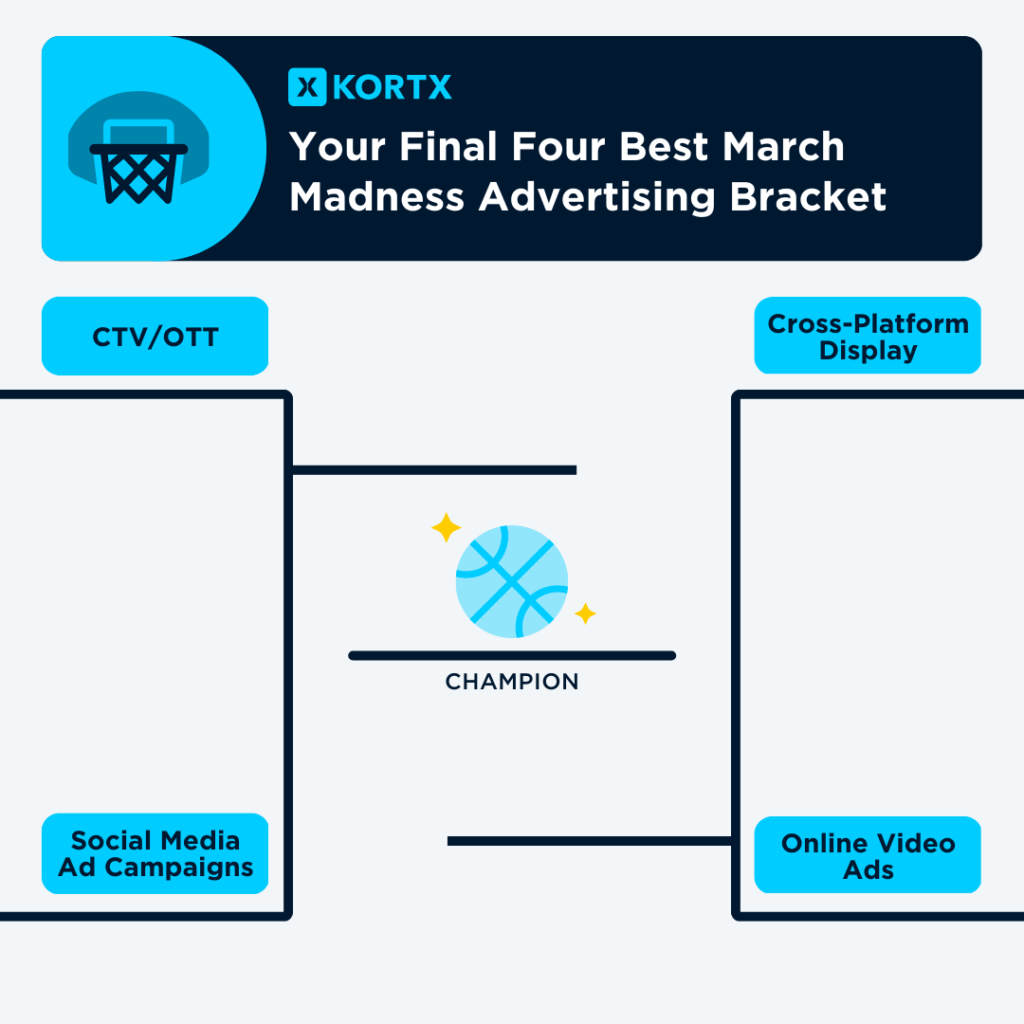
1. CTV and OTT: Capture Cord-Cutters
It hasn’t taken long for CTV and OTT to change the advertising game. Revenue from OTT video increased from $72.52 billion in 2017 to $321.50 billion in 2023–a growth of approximately 343.5%!
It’s no secret Linear TV faces increasing competition from OTT and CTV platforms, which offer more targeted advertising and greater flexibility for viewers.
On average, cord-cutters and cord-trimmers watched nine games (excluding the final four and the championship game), while linear households watched around seven games.
💡 What marketing medium would you recommend for March Madness?
“Given the impressive amount of content and coverage surrounding the event, March Madness is an excellent time for brands to advertise. CTV is a great medium to capture the ever-growing pool of users who are cutting the cord while also engaging with casual fans who are only watching to see which team – and maybe their bracket – will be the cinderella story this year.”

How can brands use CTV/OTT advertising during March Madness?
March Madness viewing habits have changed, with more people cutting the cord than ever before and young people streaming across various devices.
So, not only are CTV and OTT growing, but cord-cutter and trimmer viewers view more of March Madness than Linear TV viewers, making it a slam-dunk platform for advertisers looking to reach engaged and enthusiastic sports fans.

📺 How can brands cut through the clutter with CTV ads during March Madness?
“To stand out from the competition, brands must create compelling CTV advertisements that lead viewers to a website or app featuring a persuasive end screen.”

KORTX worked with Tropical Smoothie Cafe to add QR codes to its CTV ads. This ad encapsulates the topical beach location, frenetically changing from scene to scene to entice viewers to enjoy some tropical life at home. Notice how a QR code pops up after the first dancing sequence to encourage viewers to order a smoothie.
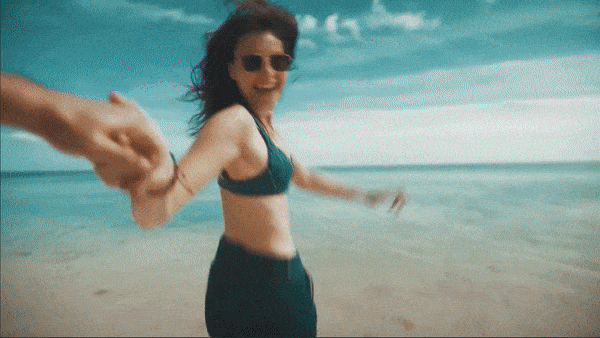
By scanning the QR code with their smartphone or tablet, we direct users to its website to earn a promotion, learn more, or purchase.
📚 Related article: QR Code Magic: Enhancing CTV Advertising Viewership: Learn more about how to use QR codes in your CTV campaigns.
QR codes also offer advertisers increased traceability because any time a user scans the code, it’s like clicking on an ad. Any time someone scans the ad, their usage is tracked and includes information like the scan location, number of scans, what time the scans took place, and the device’s operating system.
As the industry moves from traditional linear broadcasting to streaming and social media, brands can benefit from this rapid evolution by combining both worlds.
For example, McDonald’s FIFA World Cup campaign featured Jason Sudeikis as Ted Lasso (his character from the Apple TV+ original series).
Their star-studded campaigns included TikTok personality Khaby Lame, K-pop artist ITZY, and Twitch streamer Edwin Castro.
Brands can use clickable end cards, in-app ads directing viewers to their website or app, or work with social media influencers to create sponsored content.
Who builds brackets for March Madness?
ESPN had 17.3 million brackets completed for their Men’s NCAA Tournament Challenge, and, despite the NCAA’s efforts to raise the visibility of the women’s tournament, only 1.5 million brackets were completed for ESPN’s Women’s Tournament Challenge.
That’s 11 times fewer March Madness Brackets for the women’s tournament than the men’s. However, the future isn’t bleak–ESPN reported that bracket entries have tripled in the last three years of the tournament.
2. Online Video Ads: Target Computer Users
People spend more and more time watching online videos (videos on desktops, laptops, and tablets) every year. In 2018, people only spent about one hour and 38 minutes watching digital videos, but in 2023, that number jumped to around three hours and 11 minutes!
A 2020 survey revealed that TVs remained the most commonly used device for watching online video content, followed by computers, which around half of the respondents used.
💻 Interesting Fact About Online Video Ads
In 2023, the amount of money US advertisers spend on digital video programmatically will surpass linear TV ad spending. Nearly 9 in 10 of all digital video ad dollars will be transacted programmatically for the next few years.
Consumers can stream content anywhere at any time with these devices because they are portable and easily carried around, providing greater convenience and flexibility in terms of when and where they can access online videos.
Online video ads might be the best way to target people who are always on the go or prefer to watch their favorite content outside traditional living room settings.
How can brands use online video ads during March Madness?
With online video ads, advertisers can choose between in-stream, out-stream, and interactive video as well as pre-, mid-, and post-roll, and typically offered in :15- or : 30-second video assets measured by VCR.
Examples of How Brands Can Use Online Video Ads
Brands can use a variety of online video ads to target consumers during the tournament.
In-Stream Ads
In-stream ads play before, during, or after the main video content the viewer intends to watch. Skippable or non-skippable, and can run on any device.
A sports apparel brand could run a 15-second in-stream ad just before a March Madness game starts, showcasing their latest basketball gear collection and encouraging viewers to visit their website to check out the products.
Out-Stream Ads
Outstream ads appear outside of a video player. Can be placed within articles, in social media feeds, or in other contexts that are not directly related to video content..
A beverage brand could run a 30-second out-stream ad on a sports news website featuring friends watching March Madness games while drinking the brand’s product and having a good time.
Interactive Video Ads
With interactive video ads, viewers interact with the ad, including clickable buttons, forms, quizzes, or other interactive elements that encourage viewer engagement.
A snack brand could run an interactive video ad allowing viewers to play a basketball game within the ad, where they can score points and win prizes redeemed on the brand’s website.
Pre-Roll Ads
Pre-roll ads play before the main video content the viewer intends to watch. Skippable or non-skippable, and can run on any device.
A ticket booking website could run a 15-second pre-roll ad before a stream, promoting discounted ticket prices and encouraging viewers to book seats for the upcoming games.
Mid-Roll Ads
Mid-roll ads play during the main video content the viewer intends to watch. Non-skippable (usually) and can only be placed within longer video content.
An electronics brand could run a 30-second mid-roll ad during a stream, showcasing their latest smart TVs and how they can enhance the viewing experience for sports fans.
Post-Roll Ads
Post-roll ads play after the main video content the viewer intends to watch. Skippable or non-skippable, and can run on any device.
A pizza delivery chain could run a 30-second post-roll ad after a game stream, featuring a special discount code for viewers to order their favorite pizza and enjoy it while watching the next game.
These are only hypothetical examples of how advertisers can use online video ads to enhance their March Madness marketing strategy.
🏀⭐ A winning strategy that sells.
Our experienced expert team can provide guidance and support throughout the entire advertising process, from creative execution to campaign analysis and optimization.
3. Cross-Platform Display: Engage Across Various Devices
Cross-platform display saw a 38% interactions increase with official NCAA social media handles.
What’s more, during a March Madness live telecast, 20% of engagements resulted in a second screen opportunity, with viewers exposed to an average of seven ad impressions.
Within an hour of watching the game, 41% of March Madness viewers checked ad-addressable websites, most visiting new sites, and 59% of these second-screen experiences occurred on mobile devices.
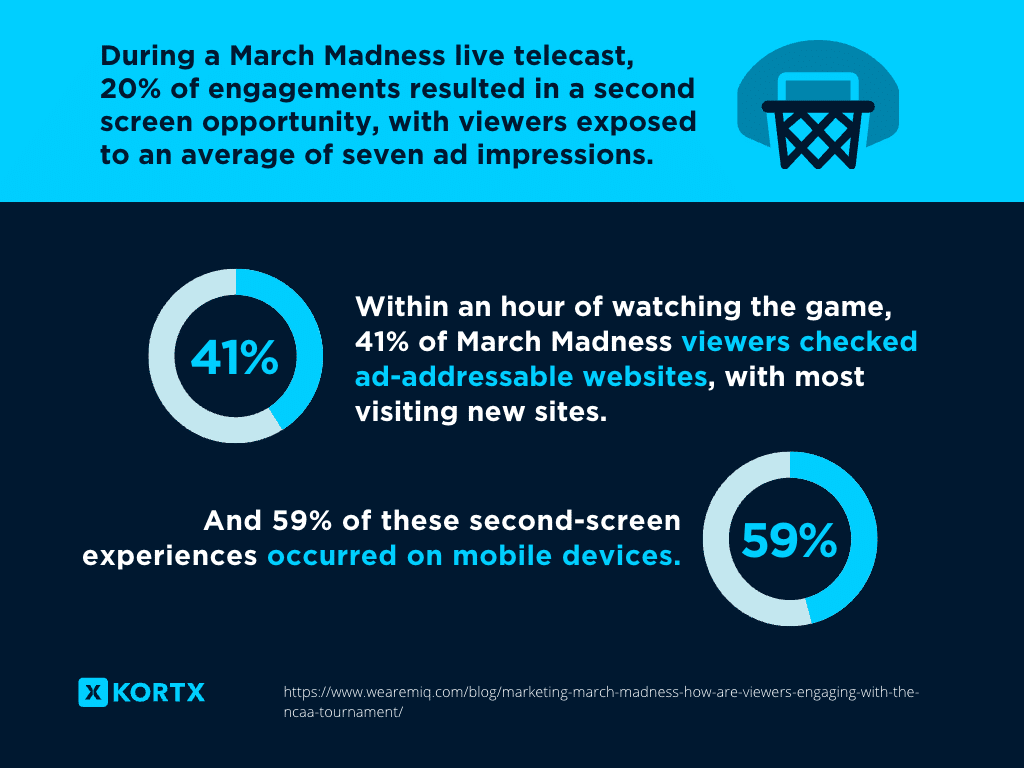
And, in case users can’t get enough college basketball, in 2022, Turner and CBS Sports rolled out a feature in the NCAA March Madness Live app that allows users to watch two games at once (one sans audio) on more platforms:
- Android TV
- Apple TV
- Fire TV
- Google TV
- Xbox One
Viewers can watch multiple games simultaneously, meaning marketers have double the advertising opportunities.
Cross-platform advertising reaches consumers at different stages of the consumer journey by using various touchpoints that are relevant to the consumer, such as seeing an ad on television and then following up with a display ad on a site that the consumer is likely to use, such as a news site or YouTube.
This way, advertisers can increase the chances of consumer engagement and ultimately drive conversions.
📲 What makes March Madness an ideal platform for cross-device advertising?
“One of the unique aspects of March Madness is how viewers watch the games. There is a higher propensity to stream these games from mobile and desktop (as opposed to an event like the Super Bowl, which is primarily big screen.) Given the multiple devices in play, it scales better cross-device in terms of attribution—an opportunity to use sequential messaging. We can assume we’ll see the same users for at least a few tournament rounds.”

How can brands use cross-platform displays for advertising during March Madness?
March Madness is a prime opportunity for advertisers to take advantage of as many advertising opportunities as possible by turning to cross-platform displays.
Cross-platform displays aim to reach as many consumers as possible across multiple devices and touchpoints and display ads in a complementary way.
For example, a beer brand could run a TV ad during a March Madness game and then use display ads on social media and popular beer-related websites to promote special promotions or deals for the tournament.
During the Super Bowl, Doritos aired its iconic triangle ad featuring Jack Harlow and Elton John. Although Harlow got snubbed for the Triangle Player of the Year award, Doritos still won out by displaying its ad on social media and as a new banner on its website.
Linear TV ad:
Social media post:
View this post on Instagram
Website banner ad:

💰 How Much Does March Madness Advertising Cost?
A 30-second spot during a Final Four game is up to $2.2 to $2.3 million, with total ad spends above $1 billion. That’s a lot of nachos and beer money!
4. Social Media Advertising: Increase Your Brand’s Reach
In the first two days of March Madness, related conversations reached over 576,000 engagements and 1.57 billion impressions on Twitter.
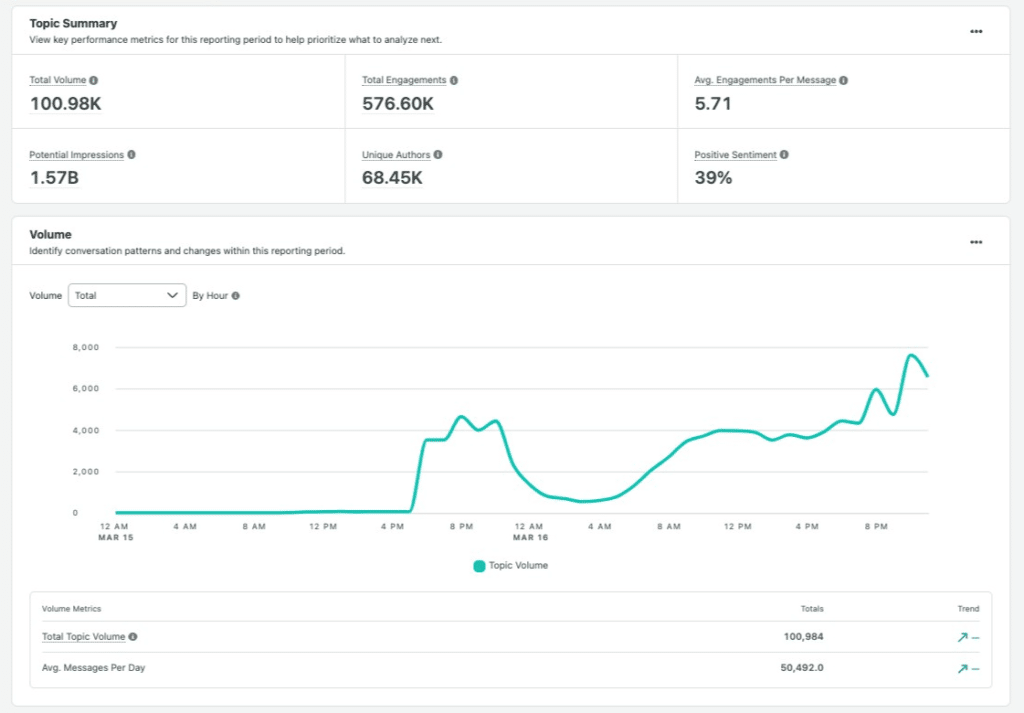
In the second round (and the first weekend of play), engagements fell to around 1.92 million, while impressions dropped to 3.84 billion.
Sprout Social also researched which states and regions were most active, with the highest total engagements from March 14-21 being:
- New York
- New Jersey
- Texas
- Indiana
- North Carolina
Unsurprisingly, these states also had fan bases with (or close to) teams headed to the Sweet Sixteen.
These social media metrics show the potential for marketers to invest in this advertising type.
How can brands use social media advertising during March Madness?
Social media is an integral part of March Madness, so much so that even Twitter saw a 291% increase in video views on college basketball during the tournament.
Let’s see how some brands use social media to market during March Madness.
Social media contests
Brands can create contests and challenges on social media platforms like Twitter, Instagram, and Facebook to engage users during March Madness.
PetFoodDirect.com gave users the chance to vote for their favorite March Magic team (or pup) for a chance to win a DoggieNation sports jersey.
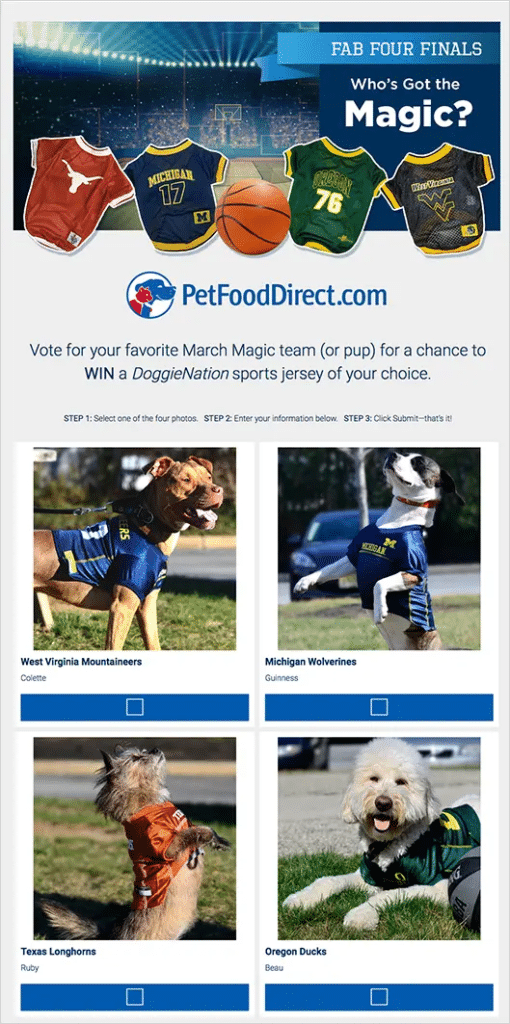
Branded hashtags
Brands can create custom hashtags for March Madness and encourage users to use them in their posts.
Wendy’s created #ForTheWendys to promote their annual Twitter event, Wendy’s March Madness Pick ‘Em. The promotion received around 1,000 engagements, 934 likes, and 4.35 million potential impressions.
Hit the ❤️ if you’re hype Wendy’s Pick ‘Em is BACK!
We’ll hit you up when it’s time to make your picks for EVERY round of March Madness.
Winning picks win sweet deals, so Choose Wisely #ForTheWendys pic.twitter.com/iWyxTaN8vO
— Wendy’s (@Wendys) March 16, 2022
Overall, a Wendy’s case study found that this campaign resulted in a 12% lift in foot traffic, 140 million total impressions, and over 2 million Twitter engagements.
Influencer marketing
Brands can collaborate with popular influencers to promote their products during March Madness.
Since the historic Supreme Court decision, student-athletes are now partnering with name brands like Nike, Dollar Shave Club, Bose, and others to help generate buzz.
Bose partnered with Aliyah A. Boston, Chet Holmgren, Jalen Duren, and Wendell Moore for its #RuleTheQuiet campaign.
Locking in starts with blocking out the noise. Eyes on the national championship. #TeamBose pic.twitter.com/8yXyO0nYUB
— Aliyah A. Boston (@aa_boston) March 14, 2022
No basketball star should have to hear their haters.
The March Madness Marketing Rules
The NCAA has strict rules surrounding March Madness advertising. To avoid running into any issues, avoid using the following terms in any of your marketing materials:
- The Big Dance
- March Madness
- Sweet Sixteen
- Elite Eight
- Final Four
Also, don’t use the NCAA or March Madness logos on your marketing materials during the tournament season.
Source: https://www.bfvlaw.com/ncaa-trademarks-think-twice-before-advertising-march-madness/
How should my brand advertise during March Madness?
Figuring out what type of marketing will work best for your brand is not as complicated as it seems. Ask yourself who you are trying to reach and what you are trying to accomplish. Dig into your current successes and the options in front of you to discover unique opportunities. Once you’ve decided on your goals, the tactic will clear.
📅 March Madness 2024 Dates
Get Your Brand in the Game
So, if you want to be a real player in the advertising game during March Madness, it’s time to get in the zone, put on your lucky jersey, and start strategizing your winning advertising plays.
🔍 👪 Looking for a reliable partner to help you quickly connect with the right audience?
Our expert strategists analyze your brand, audience, and competition, delivering data-driven recommendations that outperform generic tools.
About the Author
Rondell Wilson is an Ad Operations Specialist at KORTX. His hobbies include optimizing ad campaigns, coaching and playing basketball, and learning the forever-changing digital marketing landscape.
